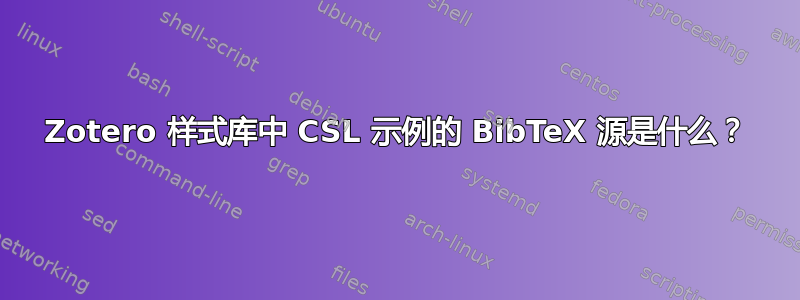
我在用pandoc加上BibTeX选定的书目中超风格以各种输出格式的文档。
pandoc --bibliography=previews.bib --csl=american-medical-association.csl -o output.pdf input.md
这Zotero 参考管理器提供广阔的CSL 样式存储库下面是一个重复的样本书目美国医学会中超风格。
我正在尝试重现看起来像@INBOOK{Hogue条目的内容,但结果却不尽如人意。我想知道是否有人可以帮助我获得一个 BibTeX 源文件,该文件可以以任何 CSL 样式正确重现 Zotero 示例书目?这将是一个方便的测试参考。
- Sambrook J,Russell DW。分子克隆:实验室手册。第 3 版。纽约冷泉港:CSHL 出版社;2001 年。
- Kötter P, Ciriacy M. 酿酒酵母发酵木糖。应用微生物生物技术。1993;38(6):776-783。doi:10.1007/BF00167144。
- Pear R. 危机促使税收措施付诸实施。纽约时报。http://www.nytimes.com/2008/10/02/business/02tax.html。2008 年 10 月 2 日发布。2008 年 10 月 4 日访问。
- 通过通信网络下达采购订单的方法和系统。1999 年。可从以下网址获取:http://www.patentstorm.us/patents/5960411.html. 2008 年 10 月 4 日访问。
- Hogue CWV.结构数据库。收录于:Baxevanis AD、Ouellette BFF 编。生物信息学。第二版。生命科学系列。纽约:Wiley-Interscience;2001:83-109。
答案1
- 来源:
previews.json - 转换为 BibTeX:参见Zotero 论坛讨论
- 自动转换不完整。出版日期字段必须手动输入。Bibtexkeys 也是手动创建的。
最终,转变过程教会了我们一个有趣的教训:
@INBOOK条目不应使用。请@INCOLLECTION改用。
此外,CSL 风格的错误可能是更正。
快乐的中超联赛测试!
input.md
test file[@Sambrook.2001; @Kotter.1993; @Pear.2008; @patent; @Hogue.2001]
previews.bib
% Encoding: UTF8
@INCOLLECTION{Hogue.2001,
author = {Hogue, Christopher W. V.},
title = {Structure Databases},
booktitle = {Bioinformatics},
publisher = {Wiley-Interscience},
year = {2001},
editor = {Baxevanis, Andreas D. and Ouellette, B. F. Francis},
series = {Life Sciences Series},
pages = {83--109},
address = {New York, {NY}},
edition = {2},
isbn = {0471383910}
}
@ARTICLE{Kotter.1993,
author = {Kötter, Peter and Ciriacy, Michael},
title = {Xylose fermentation by Saccharomyces cerevisiae},
journal = {Applied Microbiology and Biotechnology},
year = {1993},
volume = {38},
pages = {776--783},
number = {6},
month = {March},
abstract = {We have performed a comparative study of xylose utilization in Saccharomyces
cerevisiae transformants expressing two key enzymes in xylose metabolism,
xylose reductase ({XR)} and xylitol dehydrogenase ({XDH)}, and in
a prototypic xylose-utilizing yeast, Pichia stipitis. In the absence
of respiration (see text), baker's yeast cells convert half of the
xylose to xylitol and ethanol, whereas P. stipilis cells display
rather a homofermentative conversion of xylose to ethanol. Xylitol
production by baker's yeast is interpreted as a result of the dual
cofactor dependence of the {XR} and the generation of {NADPH} by
the pentose phosphate pathway. Further limitations of xylose utilization
in S. cerevisiae cells are very likely caused by an insufficient
capacity of the non-oxidative pentose phosphate pathway, as indicated
by accumulation of sedoheptulose-7-phosphate and the absence of fructose-1,6-bisphosphate
and pyruvate accumulation. By contrast, uptake at high substrate
concentrations probably does not limit xylose conversion in S. cerevisiae
{XYL1/XYL2} transformants.},
doi = {10.1007/BF00167144},
timestamp = {2008.10.04},
url = {http://dx.doi.org/10.1007/BF00167144}
}
@ARTICLE{Pear.2008,
author = {Pear, Robert},
title = {Crisis Puts Tax Moves Into Play},
journal = {The New York Times},
year = {2008},
month = {October},
chapter = {Business},
timestamp = {2008.10.04},
url = {http://www.nytimes.com/2008/10/02/business/02tax.html}
}
@BOOK{Sambrook.2001,
title = {Molecular Cloning: A Laboratory Manual},
publisher = {{CSHL} Press},
year = {2001},
author = {Sambrook, Joe and Russell, David William},
address = {Cold Spring Harbor, {NY}},
edition = {3},
month = {January},
isbn = {0879695773},
shorttitle = {Molecular Cloning}
}
@PATENT{patent,
nationality = {US},
number = {5960411},
year = {1999},
yearfiled = {1997},
title = {Method and system for placing a purchase order via a communications
network},
day = {28},
month = {September},
url = {http://www.google.com/patents/US5960411},
abstract = {A method and system for placing an order to purchase an item via the
Internet. The order is placed by a purchaser at a client system and
received by a server system. The server system receives purchaser
information including identification of the purchaser, payment information,
and shipment information from the client system. The server system
then assigns a client identifier to the client system and associates
the assigned client identifier with the received purchaser information.
The server system sends to the client system the assigned client
identifier and an {HTML} document identifying the item and including
an order button. The client system receives and stores the assigned
client identifier and receives and displays the {HTML} document.
In response to the selection of the order button, the client system
sends to the server system a request to purchase the identified item.
The server system receives the request and combines the purchaser
information associated with the client identifier of the client system
to generate an order to purchase the item in accordance with the
billing and shipment information whereby the purchaser effects the
ordering of the product by selection of the order button.},
timestamp = {2008.10.04},
}


